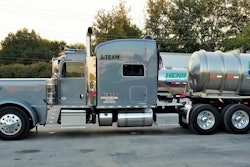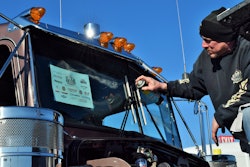Previously in this series: Dennis Holliday: A ‘smart’ move to hazmat chemical tanks
 Owner-operator J.D. Howard has owned his 1995 Kenworth W900L since 2009, with 1.5 million miles and the Caterpillar engine overhauled for the second time in its 24-year life two years ago. Howard also gave the truck a custom overhaul, with an ICT sleeper fashioned to resemble a 1980s Double Eagle design, a Jones Performance hood with a ’70s A-model look and more. Catch a video run through it from his show truck competition at the Mid-America Trucking Show via this link.
Owner-operator J.D. Howard has owned his 1995 Kenworth W900L since 2009, with 1.5 million miles and the Caterpillar engine overhauled for the second time in its 24-year life two years ago. Howard also gave the truck a custom overhaul, with an ICT sleeper fashioned to resemble a 1980s Double Eagle design, a Jones Performance hood with a ’70s A-model look and more. Catch a video run through it from his show truck competition at the Mid-America Trucking Show via this link.Four years ago, owner-operator J.D. Howard joined Dan Ratta’s Marshallville, Ohio-based small liquid-asphalt-hauling operation, Ratta Trucking. Two years later, he purchased one of Ratta’s 42-foot 7,500-gallon all-aluminum insulated 2015 Polar high-heat asphalt tankers, a piece of equipment that when new went for around $65K.
The aluminum design sacrifices on temperature – it’s rated for up to 375 degrees, whereas a steel barrel can handle more like 500, Howard says – but delivers on payload. Aluminum construction allows for 3,000 pounds of extra capacity.
“There’s the money right there,” says Howard, of Wooster, Ohio. He’s paid 90 percent of the gross on every load he hauls under Ratta’s authority, most figured by the ton-mile. The typical freight doesn’t require the 375-degree maximum.
 Owner-operator J.D. Howard
Owner-operator J.D. Howard“Right now I’ve only got 24 tons’ worth — it’s about 5,600 gallons of this material,” he said, picked up near Cleveland, bound for the Detroit area. He was “a little light” on his load that day. “The thinner stuff, we get almost 6,000 gallons sometimes” before maxing out on weight.
One benefit Howard sees over other tank operations in his asphalt-dedicated gig is its mostly local character. It’s usually picking up from and delivering to refineries, asphalt producers and other manufacturers around the Great Lakes region. He’s home most nights, perhaps the central reason he transitioned to tank after a decade flatbedding and eight years of running general freight.

Also: “no tank washes,” he says, thus minimal waiting at any place other than facilities or the jobsite. Asphalt dilutes with diesel and still can retain adhering properties. “We’ll go to jobsites, and they mix a lot of products with diesel to give it a new placard number,” he says, and the diluted mix leaves the tank much cleaner.
One downside is asphalt can be messy on hot and windy days during load or unload. Floating asphalt “cobwebs” stick to clothes, skin, hair and everything else, Howard says, though generally the physical work involved is minimal. Another drawback is that loading facility wait times can stretch a workday to 12 or more hours. “Not a hard job other than the hours.”
His first year in the business wasn’t quite as good in terms of income as his best flatbedding year. But with time and improvement in the ton-mile rates Ratta’s getting, “last year was about $40,000 more [in revenue] than I ever made,” Howard says.
Next in this series: Mike Landis: Managing sticky situations in food-grade liquid bulk










